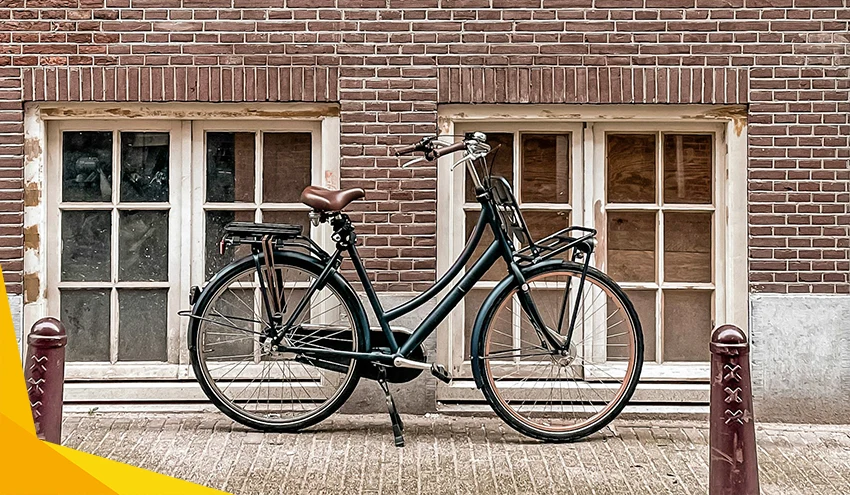Contents
- Script:
- 1. Graphene Frames
- 2. More Wireless Controls
- 3. ABS Brakes
- 4. Carbon Belts & Integrated Shifting
- 5. More E-Bikes on the Road (and the Trails)
- 5. Better Safety Standards
- 6. E-Sports & VR Technology
- 7. 1x Drivetrains Will Become the Standard
- 8. Radical Frame Designs
- 9. Stock Power Meters
- Like what you read? Share your thought below or on Facebook
Script:
Cycling has come a long way from riding on heavy steel contraptions and penny-farthing bikes to sophisticated aluminum and carbon machines.
Many of the super-bikes we are riding today look as if they were stolen from a sci-fi movie set. However, if we use our imagination, the bicycles of the future will look even more impressive and even more technologically advanced.
Many cycling enthusiasts claim that there is no room for improvement of something that is already perfect. As fellow bicycle lovers, we agree up to a part, but we still welcome the technological advancements.
If you share our opinion, here are some predictions of what the future of bicycles will most probably look like. They’ll certainly make your feet itchy for a ride.
1. Graphene Frames
Carbon frames are slowly becoming the industry standard for mid-range and high-mid-range bikes. They offer plenty of stiffness when we need it the most and are incredibly lightweight.
Just a decade ago, the average cyclist was dreaming about being able to afford a carbon frame. Now that we have it, we’d like to have more. Things are all of a sudden not stiff and not light enough for the insatiable thirst for performance.
Luckily, the cycling industry is once again teaming up with science to meet our desires. This time, their solution is called graphene. This magical material has the thickness of just one carbon atom and performs much better in all spheres.
The industry started talking about it a few years ago and some prototypes of bikes with frames made from it are already here. One of these is the Dassi Interceptor, which has a frame that weighs just 800g.
That’s impressive, but not groundbreaking. However, the Dassi CEO, Stuart Abbott claims that they will be able to manufacture a frame that weighs just 500g in the near future. We can’t wait to get our hands on it!
2. More Wireless Controls
Modern technology has brought us numerous advantages and made things easier and faster when it comes to cycling. However, it also brought along a thing that everybody hates – Cables. Lot’s of them!
In the future, it’s highly likely that we will be able to get rid of all of them. We tried hiding the cables on our bikes with internal routing to make our bicycles more sleek and minimalistic, which worked only partially.
Wireless controls are already here, even though they are still not affordable for everyone’s pocket. Shimano’s Dura-Ace Di2 and SRAM’s Red eTap are ground-breaking technologies, showing us what’s possible with a little bit of vision and technology.
In the near futures, wireless controls are most likely going to become the industry’s standard. Dropper posts are likely to be controlled wirelessly as well. That would make bicycles both look better and perform better.
3. ABS Brakes
ABS brakes have made our cars a lot safer than they were before. Skidding is much less likely to happen and braking distances have become shorter quite a bit. Could we achieve the same improvements in cycling? And do we actually need it?
Several companies have already started fidgeting with this idea, but there are none commercial solutions yet. Some examples include Outbreaker and Brake Force One, which perform well and are not too bulky.
These braking systems use sophisticated speed sensors which detect when the wheel has completely stopped moving after the brakes have been activated. Once that happens, it quickly releases the brakes to allow the wheel to move slightly and prevent skidding.
It’s doubtful whether professional cyclists and cycling enthusiasts actually want anti-lock brakes. But when it comes to city riding, anti-lock braking systems for bicycles would absolutely revolutionize the safety standards.
4. Carbon Belts & Integrated Shifting
What does the average cyclist hate most about their hobby? We can bet most of them would answer cleaning and replacing their chains and drivetrains every so often.
Compared to cars and motorcycles, bicycles endure a lot more wear and tear because of the nature of their mechanics. However, that could be solved by replacing the metal chain with a carbon belt and the exposed drivetrain with integrated shifting.
Carbon belts and enclosed gearboxes are already a reality in cycling. One example is Pinion Bikes which use the Pinion Drive Technology. They require no cleaning and no lubricating, as well as no additional adjusting. The average carbon belt will last much longer than the average chain.
However, they are still much more expensive than the average bike. In the future, we will certainly see a lot more folks zooming around the cities riding on bikes that sport this clever solution.
5. More E-Bikes on the Road (and the Trails)
The stigma surrounding e-bikes is still here, but it is slowly lifting with every day on the road and on the trails.
When e-bikes first came around, most people thought they are not worthy of carrying the name “bicycle” and people who rode them should not be allowed to carry the esteemed title of being a “cyclist.” Some still think that way, but the majority have realized how many benefits e-bikes have and how much fun they can bring into the sport.
E-bikes have already infiltrated every field of cycling, including road, mountain, and city. In the near future, we are bound to see their prices going down and their numbers going up both on the road and on the trails.
The electric motors and the batteries are likely to become smaller and lighter. Therefore, e-bikes of the future will probably look the same as “real” bicycles.
This is quite important because, consequently, the future roads will see many more bicycles than cars as people who thought cycling was too hard would start commuting on two wheels more often.
5. Better Safety Standards
Safety in cycling will be taken to another level in the future. We have already mentioned ABS brakes, but there are many other spheres where improvements can be made.
Some of the first ones that come to mind are helmets, lights, and clothing. Even though there are many ways in which cyclists can make themselves more visible when riding at night or on a gloomy day, many of these solutions are clunky and uncouth.
In the future, helmets, lights, and clothing are expected to merge with smart technologies to create a result that cyclists would be willing to use regularly.
For example, smart lights that can detect acceleration and deceleration and act as brake lights as well are already here. In a couple of years, they will probably become the standard.
Moreover, the cycling world might soon see smart cycling garments that integrate technologies which will make cyclists safer and more visible on the road. Cyclists are most visible when they are wearing moving lights, so one of the solutions is to merge them with the clothing itself.
6. E-Sports & VR Technology
Indoor training systems like Zwift have made cycling indoors fun, challenging, and desireable. Some cyclists even prefer staying inside out of the elements like sun, rain, cold, or snow, and away from the dangerous traffic.
How likely is it that we will have a virtual Grand Tour in the near future? We’d say very! Real-world cycling races and championships are never going to get old and unattractive. However, as more and more people turn to Zwift and other indoor virtual trainers, the need for a racing spectacle is going to increase more and more.
Moreover, VR technology will make things even more realistic and more entertaining. Imagine being able to wear your VR goggles on a gloomy winter day and be transported to a sunny road in a forest or on a mountain for a refreshing session. That’s already possible, but more realism and sophistication is definitely needed.
We can’t wait to see more of that!
7. 1x Drivetrains Will Become the Standard
Removing one sprocket from chainsets was a bold move by bike manufacturers. But it turned out that the results were pretty good. We got drivetrains with higher gear ratios and lower weight.
So far, 1x drivetrains with 1×10, 1×11, and 1×12 combinations have been reserved for more expensive mountain bikes. As time goes by, they are becoming cheaper and cheaper and available on more affordable bikes as well.
In the very near future, probably all trail and mountain bikes will sport 1x drivetrains, sending the second and third sprocket into oblivion.
However, 1x systems just don’t cut it when it comes to road biking. They don’t provide a high enough gear-ratio necessary for all terrains and situations we might encounter on the roads.
8. Radical Frame Designs
Do you think something that’s already deemed perfect could become even better in the future? We’re talking about frame designs and the abolishment of the beloved double-diamond frame.
Even though nobody’s complaining about the shape of today’s frame, numerous bike manufacturers are literally breaking their moulds and experimenting with new shapes. Most of these are non-double-diamond designs.
Frankly, many of these sci-fi cycling prototypes look nothing like bicycles, except that they still roll on two wheels.
Even though many cyclists don’t want it, that’s exactly what they are going to get in the near future. However, they’ll probably complain less when they start riding bikes that are more aerodynamic, much lighter, faster, and more durable.
Some modern Triathlon and TT bikes are already experimenting with these principles, but we will be seeing the same trends in road biking as well. It’s less probable that the same will happen in mountain biking, but the suspension will surely get a revamp soon as well.
9. Stock Power Meters
One of the best things you can do for your training regimen and cycling performance is investing in a power meter. However, that means spending hundreds of dollars on top of investing thousands in a high-end bike.
That makes it not worth the effort and the price tag to purchase a power meter for a mid-range bike. Most often, a power meter (along with a bike computer) will require spending half the money (or more) that you have already spent on your bike.
One of the future trends that will become more frequent is stock power meters. Manufacturing them and installing them on bikes will become cheaper than today, which means they will become standard equipment even on mid-range bikes intended for fitness riders.




